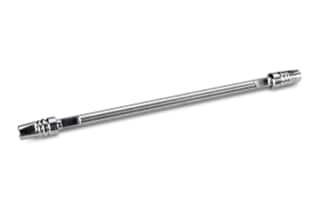
|
Chemistry |
DEA |
|
Separation Mode |
SuperCritical Fluid (SFC) |
|
Particle Substrate |
Hybrid |
|
Temperature Limits |
60 C |
|
Maximum Pressure |
6000 psi (415 Bar) |
|
Endcapped |
No |
|
Particle Shape |
Spherical |
|
Particle Size |
5 µm |
|
Endfitting Type |
Waters |
|
Pore Size |
130 Å |
|
Format |
Column |
|
Surface Area |
185 |
|
System |
UPC2, SFC |
|
Technique |
SFC, SFC/MS |
|
Inner Diameter |
2.1 mm |
|
Length |
150 mm |
|
UNSPSC |
41115711 |
|
Brand |
Torus |
|
Product Type |
Columns |
|
Units per Package |
1 pk |

Torus DEA Column, 130Å, 5 µm, 2.1 mm X 150 mm, 1/pk
Use the Torus DEA Column to achieve good chromatographic results since it is engineered for excellent peak shape, which avoids or lowers the requirement for additives. Additionally, the lab equipment provides increased selectivity for a wide range of chemicals as well as greater resilience.
Using the Torus DEA Column, you can achieve quick, robust achiral separations. The column has been specifically engineered to give great performance by utilizing the full spectrum of capabilities of the ACQUITY UPC2 System. With novel and revolutionary 1.7 μm chemistry for convergence chromatography, the Torus DEA Column streamlines the method development process. This allows scientists to easily transition SFC achiral separations from the analytical to preparative scale.
The Torus DEA Column is built on revolutionary bonding technology that allows for the creation of an adaptable selectivity platform. The patent-pending bonding consists of a two-stage functionalization of chromatographic particles, beginning with the ethylene bridged hybrid (BEH) particle. The first stage, which is applied to each sorbent, regulates retention qualities. Selectors provide observed selectivity and influence peak shape during the individual second stage.
Explore our website to learn about the full spectrum of Waters products. In addition to our most recent offerings, you will find related products and additional variants of the same listing in our library. If you need to contact a member of our team in any of our offices across the world, the website has contact information. Aside from that, it allows you to purchase lab equipment directly from us.
Torus Columns are used to scale SFC from analytical to preparative. Torus column chemistries (Torus 2-PIC, Torus DIOL, Torus DEA, and Torus 1-AA) have a wide range of selectivity and are available in analytical and preparative column configurations of 1.7 µm and 5 µm.
You can browse our website to shop for lab equipment that meets your specific demands. You might also be interested in Torus DEA VanGuard Pre-column, 130Å, 1.7 µm, 2.1 mm X 5 mm, 3/pk; Torus Columns are specifically intended to employ the full range of ACQUITY UPC2 System capabilities to perform quick, durable achiral separations. Torus Columns' four fully new and revolutionary 1.7 μm chemistries for convergence chromatography simplify the technique development process. These columns are designed with excellent peak shape in mind, eliminating or reducing the need for additives while also providing increased selectivity for a wide range of compounds and improved robustness.
How Do You Define Quaternary Amines?
A Quaternary amine refers to an amine salt that features a positively charged nitrogen atom connected to four groups. These cationic surfactants, known as positively charged surface-active compounds, possess a strong affinity for the negatively charged surfaces of numerous microorganisms. They find extensive use as disinfectants and cleaning agents in various industries.